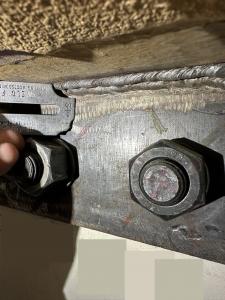Ingenious Approaches to Fillet Weld Inspection and Screening: Enhancing Weld Quality and Conformity Criteria
In the realm of welding, the quality and honesty of fillet welds play a crucial function in making sure the architectural sturdiness and integrity of numerous industrial components. With the continuous drive for boosted effectiveness and compliance with strict standards, the exploration of innovative strategies to fillet weld inspection and screening has actually come to be essential. As industries evolve, the typical approaches might no more suffice in meeting the needs of contemporary welding applications. By accepting cutting-edge modern technologies and techniques, a brand-new perspective of opportunities emerges in the realm of weld high quality assessment and adherence to compliance requirements.
Advanced Non-Destructive Testing Techniques
Making use of cutting edge modern technologies, progressed non-destructive screening techniques play a vital role in guaranteeing the honesty and top quality of fillet welds. These methods, such as phased array ultrasonic screening (PAUT) and magnetic fragment testing (MPT), deal in-depth understandings right into the weld's inner structure without creating any kind of damages to the product. PAUT, for example, utilizes several ultrasonic components to examine the weld from different angles, providing a comprehensive visualization of prospective issues like lack of fusion or fractures.
By utilizing these sophisticated non-destructive testing techniques, weld examiners can properly assess the quality of fillet welds, making certain conformity with sector requirements and policies. The ability to detect defects early on not only enhances weld quality yet likewise avoids expensive rework or failings in structural integrity, underscoring the significance of these cutting-edge screening techniques in welding evaluations.
Robotics and Automation in Evaluation
The assimilation of robotics and automation has revolutionized the examination process for fillet welds, improving performance and precision in quality evaluation. Robotics provide exact control and repeatability in examining welds, ensuring regular and reputable outcomes. Automated systems can be programmed to follow details inspection courses, making certain complete coverage of welds and lowering the danger of human mistake.
Robotic assessment systems equipped with advanced sensing units can detect and determine weld functions with high accuracy, offering thorough data for analysis. These systems can determine issues such as cracks, absence of blend, and porosity, enabling punctual rehabilitative activities to be taken. Additionally, robotics and automation allow for real-time information collection and evaluation, supplying prompt responses to operators and helping with quick decision-making procedures.
Furthermore, the use of robotics and automation in fillet weld assessment boosts overall efficiency by decreasing inspection times and increasing assessment throughput. By simplifying the assessment procedure, makers can make sure weld quality and conformity criteria are met effectively, inevitably resulting in cost savings and improved item quality.
Utilizing Expert System for Evaluation
Expert system plays an essential role in improving the effectiveness and precision of evaluation in fillet weld assessment procedures. By taking advantage of the power of AI, examiners can enhance the analysis of weld high quality and compliance standards, leading to more precise and reliable outcomes. AI formulas can quickly process vast quantities of information from weld assessments, finding issues or incongruities that might be testing to identify with the nude eye. This advanced modern technology makes it possible for real-time surveillance of weld high quality, allowing for prompt restorative actions to be taken if any kind of problems are spotted.
In addition, AI systems can pick up from previous inspection information, constantly boosting their capability to recognize possible problems and inconsistencies in fillet welds. This adaptive discovering capacity enhances the overall quality assurance procedure, reducing the possibility of human error and making sure that welds fulfill the required standards. By integrating expert system right into fillet weld evaluation, industries can achieve higher levels of effectiveness, uniformity, and conformity in their evaluation techniques.
Portable Devices for On-Site Examination
 Enhancing area inspection effectiveness, the fostering of mobile devices changes on-site analysis procedures for fillet welds. These tools supply flexibility and convenience, enabling examiners to carry out complete exams in various locations, including challenging or remote environments. Portable tools such as ultrasonic testing gadgets, magnetic their explanation fragment evaluation devices, and electronic radiography systems give real-time information and high-resolution imaging capacities, enabling quick decision-making and immediate responses on weld top quality.
Enhancing area inspection effectiveness, the fostering of mobile devices changes on-site analysis procedures for fillet welds. These tools supply flexibility and convenience, enabling examiners to carry out complete exams in various locations, including challenging or remote environments. Portable tools such as ultrasonic testing gadgets, magnetic their explanation fragment evaluation devices, and electronic radiography systems give real-time information and high-resolution imaging capacities, enabling quick decision-making and immediate responses on weld top quality.One substantial benefit of mobile tools is their ability to simplify inspection procedures, reducing downtime and enhancing overall productivity. Inspectors can conveniently move these devices to different job websites, getting rid of the demand for delivering heavy machinery or parts to off-site centers. In addition, the portability of these devices promotes cost-effectiveness by decreasing transportation costs and accelerating evaluation timelines.
In addition, making use of mobile tools for on-site inspection promotes proactive quality assurance procedures, as assessors can immediately recognize and deal with any possible welding problems or disparities. By including these ingenious technologies right into on-site examination practices, welding professionals can make sure conformity with industry criteria and enhance weld top quality, ultimately resulting in improved architectural honesty and security in various welding applications.
Integration of Information Monitoring Solution
Having enhanced on-site examination processes with the utilization of portable devices, the following phase includes the smooth assimilation of data monitoring systems to further improve performance and information analysis abilities in fillet weld examination and testing. Welding Inspection Racine. By integrating data management systems into the assessment procedure, organizations can simplify data collection, storage space, and evaluation. This combination enables real-time surveillance of weld quality, immediate identification of problems, and timely decision-making to fix any issues that may develop throughout the examination procedure
Data administration systems play a crucial function in systematizing evaluation data, assisting in simple gain access to for licensed workers, and making sure data stability and security. With the assimilation of these systems, assessors can generate comprehensive records, track historic information for pattern evaluation, and boost total procedure effectiveness. In addition, the integration of information administration systems enables seamless communication between various stakeholders associated with the inspection procedure, promoting partnership and enhancing total quality assurance procedures. Inevitably, the combination of information administration systems serves to elevate the criteria of fillet weld assessment and testing, making certain compliance with sector guidelines and improving weld high quality.
Final Thought
In conclusion, innovative techniques to fillet weld inspection and testing have actually significantly improved weld high quality and conformity standards. Advanced non-destructive screening methods, robotics, automation, expert system, mobile devices, and data monitoring systems have actually reinvented the way weld evaluations are carried out. By making use of these modern technologies, markets can guarantee that welds meet the required high quality requirements and guidelines, ultimately Continued improving overall effectiveness and safety and security in welding processes.

By using these sophisticated non-destructive testing strategies, weld inspectors can precisely analyze the top quality of fillet welds, making certain conformity with industry standards and guidelines. Mobile tools such as ultrasonic screening devices, magnetic particle evaluation tools, and digital radiography systems offer real-time data and high-resolution imaging abilities, enabling fast decision-making and prompt responses on weld top quality.
Having actually maximized on-site assessment procedures via the usage of mobile tools, the next phase includes the smooth integration of data management systems to better enhance effectiveness and information evaluation capacities in fillet weld examination and testing (Welding Inspection Racine). Ultimately, the integration of data management systems serves to raise the requirements of fillet weld inspection and screening, guaranteeing compliance with navigate to this website sector laws and boosting weld quality
 In verdict, cutting-edge approaches to fillet weld evaluation and testing have considerably enhanced weld top quality and compliance criteria.
In verdict, cutting-edge approaches to fillet weld evaluation and testing have considerably enhanced weld top quality and compliance criteria.
Comments on “Welding Inspection Racine: Making Certain Precision and Dependability in Every Weld”